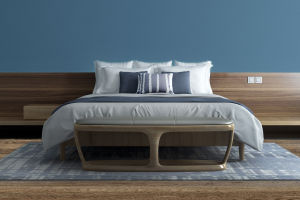Creating a functional and safe space for children in their room is a top priority for parents during the decoration process. The design of the room should consider safety and environmental protection, as well as practicality for the child's growth and development.
One important aspect to consider when designing a children's room is lighting.
The main source of light in the children's room should be chosen carefully, considering the brightness, darkness, and size of the lamps. Since children's eyes are in the developmental period, it's important to avoid strong lighting that can stimulate their eyes and cause visual fatigue.
A 20 square feet children's room should have a 30W energy-saving lamp, which provides adequate lighting without causing discomfort.
When selecting lighting fixtures for the room, parents should avoid chandeliers that hang too low, as they can create a depressing atmosphere and can be dangerous if children touch them. A better alternative is to choose ceiling lights, with the height of the light not exceeding 40cm.
Local lighting, such as a desk lamp, is essential for writing and studying in the children's room. It's important to choose a desk lamp with LED lights, as they are DC lamps that have a long life, no flickering screen, and emit soft light that is easy on the eyes. Additionally, parents should choose lamps with adjustable brightness and color temperature to accommodate different needs.
When installing a desk lamp, it's important to place it on the left side of the child, to ensure that the light source is coming from the correct angle for optimal posture during writing and studying. Also, the installation of the switch and socket should be on the left side of the desk to make it easier for the child to operate.
The materials used for wall decoration in the children's room should be carefully selected to ensure safety and environmental protection. Latex paint, wallpaper, and diatomaceous earth are popular choices for wall materials.
Latex paint is widely used due to its good decorative effect, while diatomaceous earth is gaining popularity for its natural and eco-friendly properties.
For flooring, parents can choose from a variety of materials such as flooring, floor tiles, or carpet. Flooring offers a natural and comfortable feel, while floor tiles are durable, affordable, and easy to maintain.
The carpet offers a soft texture and comes in a variety of colors and patterns, making it a great option for children's rooms.
Decorative paintings are a great way to add personality and character to a child's room. In the past, wall cloth wallpaper was a popular choice due to its durability and ease of installation.
However, in recent years, hanging paintings have become more popular, especially the new process of crystal porcelain hanging paintings. These decorative paintings are easy to install, add a unique touch to the room, and are durable enough to withstand the wear and tear of children's activities.
Designing a safe and functional children's room involves careful consideration of lighting, wall materials, flooring, and decorative elements.
By choosing the right materials and fixtures, parents can create a space that is not only visually appealing but also comfortable and safe for their children to grow and thrive in.


